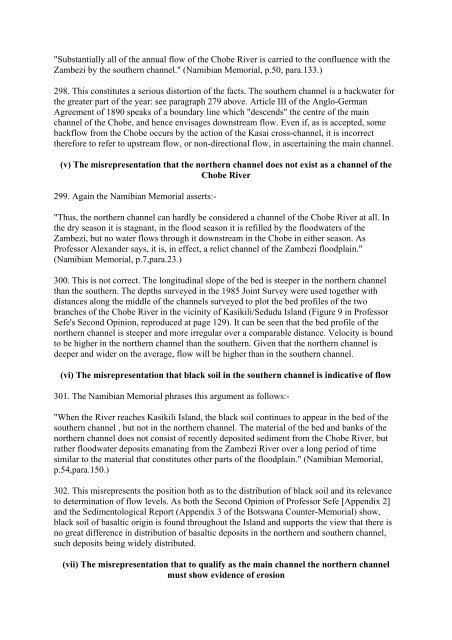botswana/namibia - Cour international de Justice
botswana/namibia - Cour international de Justice
botswana/namibia - Cour international de Justice
Create successful ePaper yourself
Turn your PDF publications into a flip-book with our unique Google optimized e-Paper software.
"Substantially all of the annual flow of the Chobe River is carried to the confluence with the<br />
Zambezi by the southern channel." (Namibian Memorial, p.50, para.133.)<br />
298. This constitutes a serious distortion of the facts. The southern channel is a backwater for<br />
the greater part of the year: see paragraph 279 above. Article III of the Anglo-German<br />
Agreement of 1890 speaks of a boundary line which "<strong>de</strong>scends" the centre of the main<br />
channel of the Chobe, and hence envisages downstream flow. Even if, as is accepted, some<br />
backflow from the Chobe occurs by the action of the Kasai cross-channel, it is incorrect<br />
therefore to refer to upstream flow, or non-directional flow, in ascertaining the main channel.<br />
(v) The misrepresentation that the northern channel does not exist as a channel of the<br />
Chobe River<br />
299. Again the Namibian Memorial asserts:-<br />
"Thus, the northern channel can hardly be consi<strong>de</strong>red a channel of the Chobe River at all. In<br />
the dry season it is stagnant, in the flood season it is refilled by the floodwaters of the<br />
Zambezi, but no water flows through it downstream in the Chobe in either season. As<br />
Professor Alexan<strong>de</strong>r says, it is, in effect, a relict channel of the Zambezi floodplain."<br />
(Namibian Memorial, p.7,para.23.)<br />
300. This is not correct. The longitudinal slope of the bed is steeper in the northern channel<br />
than the southern. The <strong>de</strong>pths surveyed in the 1985 Joint Survey were used together with<br />
distances along the middle of the channels surveyed to plot the bed profiles of the two<br />
branches of the Chobe River in the vicinity of Kasikili/Sedudu Island (Figure 9 in Professor<br />
Sefe's Second Opinion, reproduced at page 129). It can be seen that the bed profile of the<br />
northern channel is steeper and more irregular over a comparable distance. Velocity is bound<br />
to be higher in the northern channel than the southern. Given that the northern channel is<br />
<strong>de</strong>eper and wi<strong>de</strong>r on the average, flow will be higher than in the southern channel.<br />
(vi) The misrepresentation that black soil in the southern channel is indicative of flow<br />
301. The Namibian Memorial phrases this argument as follows:-<br />
"When the River reaches Kasikili Island, the black soil continues to appear in the bed of the<br />
southern channel , but not in the northern channel. The material of the bed and banks of the<br />
northern channel does not consist of recently <strong>de</strong>posited sediment from the Chobe River, but<br />
rather floodwater <strong>de</strong>posits emanating from the Zambezi River over a long period of time<br />
similar to the material that constitutes other parts of the floodplain." (Namibian Memorial,<br />
p.54,para.150.)<br />
302. This misrepresents the position both as to the distribution of black soil and its relevance<br />
to <strong>de</strong>termination of flow levels. As both the Second Opinion of Professor Sefe [Appendix 2]<br />
and the Sedimentological Report (Appendix 3 of the Botswana Counter-Memorial) show,<br />
black soil of basaltic origin is found throughout the Island and supports the view that there is<br />
no great difference in distribution of basaltic <strong>de</strong>posits in the northern and southern channel,<br />
such <strong>de</strong>posits being wi<strong>de</strong>ly distributed.<br />
(vii) The misrepresentation that to qualify as the main channel the northern channel<br />
must show evi<strong>de</strong>nce of erosion

















